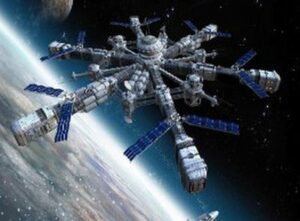XR-SPACI Mission
Please feel free to download the integral text in PDF format by clicking here

We consider this mission as fundamental because it will constitute the future base of studies and experiments for the installation of colonies in the solar system or even beyond.
First of all it is essential to create robotic and human training laboratories in order to respond to situations of extraterrestrial explorations which will represent one of the greatest challenges human beings.
The minerals most resembling land ores will be studied with the use of new machines evolving in controlled atmospheres or in micro-gravity conditions.
Without the acquisition of this future extraterrestrial engineering, learned on Earth, it will not be possible to envisage an efficient mixed installation (robots and man) on the objects of the solar system and thus to create colonies.
The plan of the job is complex, it consists in the creation of a new physics and chemistry (engineering) on the object to be colonized.
We have to be able to extract raw materials, minerals, water, rare gases and others.
We have got the technology for refining the minerals and obtaining natural elements and metals of different grades of purity (99.5 % to pure or ultra-pure grade) as on earth (PERT plasma technologies). Then we will need to construct the electrolytic and plasma tools chains, and continuously melting (patent granted) of the ores on the spot, including regoliths, and mostly Silicates, Iron, Ca, Mg. and others.
This process will be comparable to the land-based steel industry.
Metal lattices (Fe) or specialized alloys doped with other natural elements will be deposited in the parallelepiped or hemispherical crucibles at a distance of 3 cm from the bottom of the crucible- Then the molten liquids (coming from the PERT stationary plasma tools) will coat the trellis or meshes (BEE geometric).
The final product will be stored underground in the absence of high temperature variations which alter and weaken the crystalline meshes of the alloys and reduce the multiple quality and competence of these materials intended for use on the exploited soil or to for Stations and / or Spacecrafts.
The product will be stabilized from a few days to 30 days.
The quality of the finished materials will be tested according to the future applications on ground or in orbit(orbital station) or for a spacecraft.
These structures may also constitute the coatings and envelopes of equipment on site or of future orbital assembling stations and other structures.
The refined materials will be brought from the ground to the future assembly stations by means of plasma motors, the main fuel of which will be the hydrogen obtained from the water extracted from the colonized soils.
Two metal trellis output terminals will be visible and adaptable to other functions (not disclosed). The 4 lifting rings of each plate or other selected geometries will transport manufacture pieces in their places of storage and assembly.
By means of lenticular structures (HELIOTORR) 30 m to 100 meters containing Helium or possibly Hydrogen (this last, in the case that the atmosphere of the colonized object does not contain oxygen or/and important electrostatic perturbations).
The rare gases (He, Xe) will be obtained using the PERT- plasma tools machines.
These structures can have the appearance of assemblies (MECANO) with guides and easy-mounting, with locking pins and lifting rings at the four corners of the plate.
Each plate of 1 meter in length or more 3 meters will be nested with the previous one and stored.
It should be noticed that for colonized objects not having large atmospheric disturbances (above 150 km / h), the movement and missions with HELIOTORR gears will be easy.
Propulsion of HELIOTORR gear will be provided by fuel cells and plasma engines.
Hydrogen will be obtained in electrolysis stations from the water obtained from the cracking and thermolysis of certain water-rich minerals, in the case that the water does not exist naturally on the colonized soils.
These first materials being immediately found on the ground.
The objects colonized will allow the manufacture of panels, tubes, spheres, hemispheres, making it possible to construct houses for robots and humans and to protect mineral processing machines and drilling and excavation. New drilling, excavating and grinding tools will be developed, in particular a digging station, which will be the centerpiece of the mining facility, which can be robotized after periods of continuous testing.
These two (or more) stations should be able to process tons of ores per hour and produce 4 to 7 mesh plates per hour, or 15 tons per day, including automatic maintenance.
A station would be reserved for the rapid replacement of a stopped station for damage or maintenance.
New Portable XRF and portable Plasma Tools will be made available to explorers in order to test rapidly the soil and to measure especially the melting temperatures and to deposit markers of geodesic landmarks.
To be continued…
New portable Plasma tools… RADARS – MAGNETOMETERS…